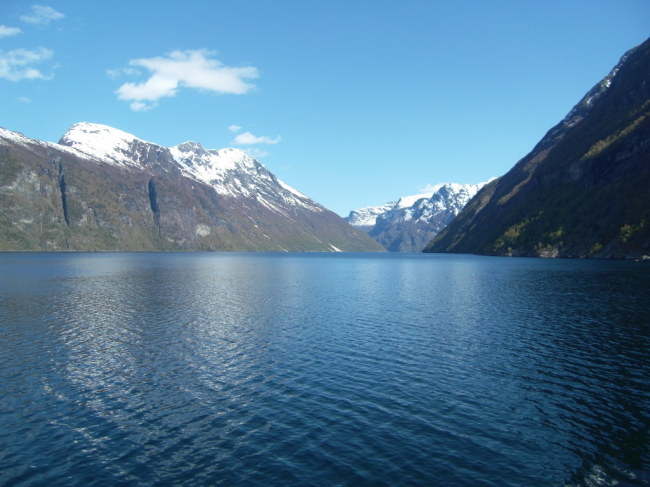GEIRANGER, Norway ― The moment you step on a ferry and travel on the waters of Geirangerfjord, surrounded by snow-peaked mountains and glittering waterfalls, all you can say about the place is: It’s mesmerizing.
Feeling the cool, fresh sea breeze hitting your face on the top deck of the ferry, and watching the fjord’s incredible nature, the trip is an instant tonic for all the stress, anxiety and burdens you may have bought from the office.
The fjord’s waterfront landscape is indescribable.
I can go on and on about how beautiful it was, showing high-resolution pictures ― which many of my friends and colleagues jokingly said they looked like calendar photos ― and sharing stories of it with those who have never been to the land of the Vikings.
The water was as clear and blue as the sky. The mountains with abundant trees were as green as they can be. The peaks, covered with snow, were so white you could feel the reflection of the sunlight from them softly touching your face. The air was so pure that you could almost taste its freshness.
But these descriptions still are not enough to do justice to this UNESCO World Heritage Site.
Like the slogan of Fjord Norway, the country’s tourism agency promoting Geirangerfjord, said: “You have to be here to believe it.”
But I would add “and feel it.”
Once the ferry started cruising from the small town of Geiranger in southwestern Norway to the village of Hellesylt, my mind became as clear as the fjord, with my hands busy taking pictures.
The hour it took to make the trip seemed like plenty of time before hopping on the ferry. But if anything, it felt too short, and I felt the urge to ride the ferry to other fjords in the region.
During the ride, which opens between May 1 and Oct. 1, I could not help but wonder how God could have created this fjord, which Fjord Norway said can be translated as: “The valley of water.”
Norway’s fjords were created by glacial erosion, and seeing Geirangerfjord reminded me of a trip I took to the Grand Canyon about eight years ago.
At the time, a tour guide explained how the Grand Canyon could have been made by 40 days of rain and floods, citing the story of Noah’s Ark and the Great Flood in the Bible.
When comparing the two fascinating geological locations, Fjord Norway’s trade relations manager Helen Siverstol said, “Geirangerfjord is the Grand Canyon with salt water.”
Like the Grand Canyon, Geirangerfjord is filled with tales and legends.
Notably, there is the Seven Sisters Waterfall, and just opposite from it, there is a single waterfall named the Suitor in the middle of Geirangerfjord.
The legend goes that seven women rejected a man’s marriage proposals, and that is why the Suitor waterfall remains alone on the other side of the Seven Sisters, whose falls are said to resemble their hair.
The ferry trip costs about $110 per car (depending on the size) for an hourlong ride, and $220 per night with breakfast included at a hotel such as Hotel Union, which has been run for four generations by the Mjelva family. Norway’s currency is the krone.
Norway, which is not part of the European Union but is one of Europe’s richest countries, can be a little expensive. There is a joke that it is cheaper and fresher to drink from a stream or lake than buying a bottle of water from a store in Norway. Also, the air is so clean that hotel clerks recommend jogging outside instead of on a treadmill inside a gym.
There are many ways to travel to this part of the UNESCO World Heritage town.
A group of reporters on a press tour flew in from Norway’s capital city of Oslo to Kristiansund, and traveled on a bus, while sightseeing the region’s natural landscapes on the famous Atlantic Road, an 8-kilometer road linking the towns of Kristiansund and Molde.
The group stayed overnight in Molde in Romsdal, then headed south by road for two hours, taking two car ferries on the way ― from Molde to Vestnes, and from Linge to Eidsdal.
Toward the town of Geiranger, there was the Eidsvatnet Lake beside road No. 63, which is known as one of the country’s best fishing spots, and the group traveled down the narrow, steep Eagle Road, which is shaped like an eagle’s wing.
The roads and streets were quiet for most of the time, with very few cars and people. Most stores close after 5 p.m., but that was all part of the charm of Norway ― the quietness and calmness ― especially for those coming from Seoul, where people usually find themselves rushing about at work and on crowded public transit.
Another way to experience Norway’s great fjords is by traveling on a cruise ferry from Alesund, dubbed the “adventure capital of the fjords.”
With about 45,000 people, the town, which is known for its Art Nouveau buildings and decorations located just southwest of Molde, is the entrance to the fjords.
It takes about a day by ferry from Alesund to Geiranger, according to Destination Alesund & Sunnmore, a tourist agency. For more information, check www.visitalesund.com.
From Korea’s Incheon International Airport to Oslo, it takes about 16 hours by Qatar Airways with about a two-hour stopover in Doha.
Qatar Airways, in which I felt comfortable and pleasant with full of movies on-demand, and quality food and beverage services throughout the flight, provides year-round services to Oslo from Incheon via Doha.
Travelers can take a quick city tour of Doha with a temporary pass while waiting for their flight in between.
Korean Air, the country’s flag carrier, provides four direct flights between Incheon and Oslo in June and July only on Saturdays.
For more information about traveling to Norway and its discount offers to Geiranger, check out www.fjordnorway.com/ and www.visitnorway.com.
By Park Hyong-ki, Korea Herald correspondent (
hkp@heraldcorp.com)








